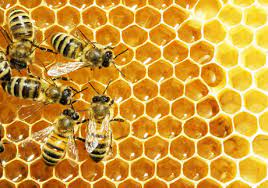
Living
Vaccine For Bees Could Offer Glimmer of Hope To Declining Bee Populations
In recent years, the world has been grappling with the alarming decline of bee populations. Bees play a crucial role in pollinating crops and contributing to the ecosystem, making their survival critical to our food supply and environment. Unfortunately, diseases, parasites, and climate change have been devastating bee populations, and many beekeepers are losing up to 50-70% of their colonies due to disease. However, a new development could be a game-changer in the fight to save bees.
A biotech company has created the world’s first vaccine for honeybees, offering hope for the survival of bee populations. The vaccine works by vaccinating the queen bee, who then passes on the immunity to millions of offspring that make up the colony. This breakthrough could revolutionize the fight against American foulbrood disease, a bacterial infection that has been decimating bee populations.
American foulbrood disease is a severe bacterial disease that affects honeybee larvae, causing them to die rapidly and emit a foul odor. When a colony is infected, all equipment and infected bees must be burned and buried, making the disease a significant threat to the beekeeping industry. The vaccine could help prevent the spread of the disease by providing colonies with immunity to the bacteria.
The vaccine is still in the early stages of development and requires further testing, but it has already shown promising results in trials. If successful, the vaccine could be a game-changer in the fight to save bees and protect our food supply. Bees are responsible for pollinating a third of the food produced in the United States, and their role in the ecosystem is worth an estimated $15 billion annually.
The decline of bee populations has become a global concern, and scientists and beekeepers have been working tirelessly to find solutions. The development of the bee vaccine could be a significant step forward in protecting these essential creatures. With the vaccine, beekeepers can help reduce the impact of diseases on their colonies and keep their bees healthy and thriving.
The creation of a vaccine for honeybees offers a glimmer of hope in the fight against the decline of bee populations. While the vaccine is not a silver bullet, it could be an essential tool in reducing the impact of diseases on bee populations. As research continues, we can only hope that this development will lead to a brighter future for bees and the important role they play in our ecosystem.
Living
Lights Out for Texas Skies: Saving Billions of Birds on Migration

Millions of birds take flight across Texas each spring, but their journeys can be perilous. Illuminated skyscrapers pose a deadly threat, attracting and disorienting birds during their nighttime migrations.
A tragic incident in 2017 highlighted the danger. Hundreds of migrating birds perished after colliding with a brightly lit skyscraper in Galveston. This event spurred a collaborative effort to protect these feathered travelers.
The culprit: artificial lights. Birds navigate by starlight, and the urban glow disrupts their internal compass. They may become confused and drawn towards the lights, leading to collisions with buildings.
Inspired by successful campaigns in other cities, the Houston Audubon Society joined forces with American National Insurance, the occupant of the ill-fated skyscraper. Together, they implemented a solution: turning off non-essential lights during peak migration seasons.
This simple yet effective strategy became the foundation for “Lights Out, Texas!” – a statewide initiative encouraging building owners and businesses to dim the lights at night. The program runs from March to June for spring migration and August to November for fall migration.
While conclusive data in Texas is still emerging, similar initiatives elsewhere have shown promising results. In Chicago, a 60% reduction in bird deaths was observed after dimming lights during migration.
The “Lights Out, Texas!” campaign is gaining momentum, with participation from major cities across the state. Volunteer birdwatchers also play a crucial role, monitoring bird interactions with urban environments and providing valuable data.
Texas serves as a vital stopover for countless songbirds like warblers and sparrows. By dimming the lights, Texas is creating a safer passage for these feathered voyagers on their epic journeys.
Living
Six-Year-Old Willow Hamrick Celebrated at the Walk to Cure Arthritis This Weekend

Willow Hamrick, a spirited six-year-old, is being honored this weekend at the annual Walk to Cure Arthritis for her brave fight against the condition. Diagnosed at just three years old, Willow has faced the challenges of arthritis with remarkable courage. Currently a first grader at Nolensville Elementary, she frequently misses school for medical appointments and undergoes weekly injections to manage her symptoms.
Her mother, Kelsey, reflects on the journey, describing it as a rollercoaster of emotions. However, she proudly notes that Willow has become adept at handling her treatment regimen, calling her a “rock star” when it comes to taking her shots.
Willow will serve as the youth honoree at the event, which is set to take place at Centennial Park on Sunday at 1 pm. The Walk to Cure Arthritis is a key fundraiser for the Arthritis Foundation, supporting vital research aimed at finding a cure for the disease that affects one in four adults and over 300,000 children in the U.S.
While participation in the walk is free, attendees are encouraged to donate in honor of Willow or others affected by arthritis. Willow herself has contributed significantly, raising over $3,000 for the foundation.
Despite her condition, Willow remains active and enthusiastic, enjoying gymnastics, art, and quality time with friends and family. She is determined not to let arthritis hold her back, embodying resilience and hope for many others facing similar battles.
Living
Advanced Technology Empowers Quadruple Amputee Jessica Haldin to Pursue Driving

Jessica Haldin, who lost her limbs to meningococcal disease at age two, once believed driving was out of her reach. Growing up in Rockingham, a suburb of Perth, she watched her friends earn their driver’s licenses, symbolizing freedom she longed for but felt was unattainable. However, now at 33, Jessica is learning to drive using a specially modified vehicle equipped to accommodate her needs as a quadruple amputee.
Five years ago, Jessica’s coordinator encouraged her to pursue driving, assuring her that she could obtain a license and secure necessary funding. Today, her vehicle is fitted with a joystick for steering, braking, and accelerating, along with a voice-activated system for controlling indicators, the horn, and other features. Despite the initial anxiety, Jessica’s first driving lesson was a profound step toward independence.
The journey to this point wasn’t simple; securing approval and funding from the National Disability Insurance Scheme (NDIS) was a lengthy process. Yet, the possibility of gaining mobility and freedom has greatly excited Jessica. She expressed a desire to escape the confines of her home life, where she largely depends on her mother, and explore places like Margaret River and Albany on her own.
Tamlyn Macdonald, Jessica’s support worker, expressed pride in her progress, noting that helping clients achieve independence is the ultimate goal of the NDIS. She looks forward to transitioning from caregiver to friend as Jessica gains more autonomy.
Mikayla Kongram, an occupational therapist and driving instructor, highlights that Jessica’s story is becoming increasingly common as technology advances. She sees daily how vehicle modifications enable those with disabilities to drive, expanding their world dramatically compared to the pre-NDIS era. Despite some individuals still facing challenges due to physical limitations, technological innovations continue to broaden possibilities, allowing more people with disabilities to experience the independence of driving.
Living
Biggest Sea Turtle Release Ever on Georgia’s Jekyll Island

In two days, Georgia will witness its largest sea turtle release ever on Jekyll Island. The Georgia Sea Turtle Center announced that over 30 turtles will be returned to the sea. These turtles come from various places like Turtles Fly Too, NOAA, Mystic Aquarium, New York Rescue Center, and New England Aquarium.
Many of these sea turtles needed help because they were cold-stunned, but now they are better and ready to go back to the ocean.
Sea turtles are fascinating creatures. They live in oceans around the world and are known for their long migrations. Some species travel thousands of miles to lay their eggs on the same beaches where they were born. They are also ancient animals, having been around for over 100 million years, which means they shared the planet with dinosaurs.
Sea turtles like to eat a variety of foods. Depending on the species, their diet can include jellyfish, seaweed, crabs, shrimp, and even small fish. They have a unique way of navigating the ocean, using the Earth’s magnetic field to find their way.
Unfortunately, sea turtles face many challenges. They are threatened by habitat loss, pollution, climate change, and accidental capture in fishing gear. That’s why the work of rescue centers and rehabilitation programs is so important to help these vulnerable sea creatures survive and thrive in their natural habitat.
Living
Drones Are A Powerful Ally For Animal Right Campaigners

Drones have become powerful allies for animal rights campaigners, offering a bird’s-eye view that’s hard to beat. These flying gadgets are not only affordable but also simple to operate, making them perfect for keeping an eye on illegal activities like fishing, hunting, and deforestation. They’re also great for monitoring conditions in zoos and aquariums.
A striking example comes from UrgentSeas, an organization that sprang into action after hearing about a lonely manatee at the Miami Seaquarium. Using drones, they captured footage of the manatee, named Romeo, in a neglected pool. The video went viral, leading to public outrage and eventually the relocation of Romeo and his mate Juliet to a sanctuary.
Since their introduction in the early 2010s, drones have been revolutionary for groups like PETA, who’ve used them to uncover illegal hunting activities. In marine conservation, drones offer an unparalleled view of the living conditions of sea creatures, highlighting the cramped spaces in some facilities.
Sea Shepherd, a marine conservation group, utilizes drones to document illegal fishing activities in international waters. The advancements in drone technology have made these devices quieter and more discreet, crucial for documenting illegal actions without alerting the perpetrators. Simon Ager of Sea Shepherd emphasizes the effectiveness of drones in these operations, noting their ability to capture evidence of illegal activities from a safe distance, thus reducing the risk to conservationists.
In essence, drones are more than just tools; they represent a shift in how activists and conservationists can safely and effectively gather evidence, raise awareness, and prompt action to protect animals and their habitats. They enable discreet observations and can reach places that are otherwise inaccessible or risky for humans, proving to be an indispensable asset in the fight for animal rights and environmental protection.
-

 OMG6 years ago
OMG6 years agoA Couple Gave Birth to the Most Beautiful Twins Ever
-

 OMG6 years ago
OMG6 years ago20 Rare Historical Photos
-

 OMG6 years ago
OMG6 years agoHilarious Airport Photos
-

 Cute6 years ago
Cute6 years agoMom Refuses to Let Daughter Eat Sugar and Years Later This is What She Grows Into
-

 OMG5 years ago
OMG5 years agoTop Secret Air Force One Facts That You Never Knew
-
OMG5 years ago
The Funniest Yearbook Photos Of All Time
-

 OMG6 years ago
OMG6 years agoRetired Mathematician Restores Log Cabin
-

 OMG4 years ago
OMG4 years agoWhat Happened When This ‘Duck Dynasty’ Legend Chopped Off His Beard?